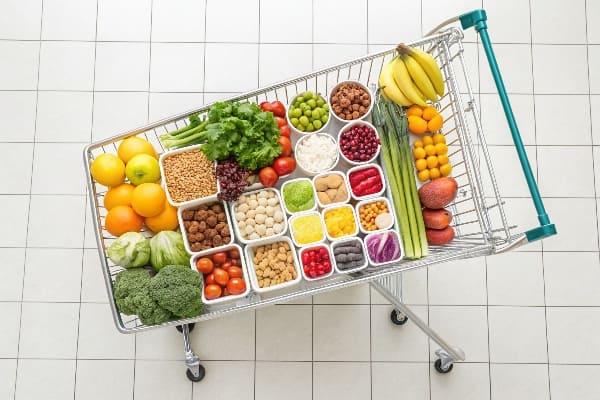How tiring is working at a grocery store?

You grab a basket, breeze through aisles, and leave, but I clock out aching, sweaty, and wired—proof that grocery work drains more than it appears.
Working at a grocery store is tiring because employees stand for hours, lift heavy cases, sprint between tasks, and juggle constant customer demands, leaving both muscles and mind exhausted before the shift ends.

Those long shifts tell only part of the story. The way we organize shopping trips, the sensory flood inside the store, and the hidden pressures behind each stocked shelf all shape how draining the experience can be. Let me break each piece down.
What is the 5 4 3 2 1 rule for grocery shopping?
Smart shoppers use simple memory tricks. The 5-4-3-2-1 rule keeps carts balanced and bodies healthier even when schedules are tight.
The 5-4-3-2-1 rule guides you to buy five fruits and vegetables, four grains, three proteins, two dairy items, and one treat, creating a quick, nutritious checklist for every trip.

Why I rely on the rule
When back-to-back closing shifts left me snacking on chips at midnight, a dietitian friend showed me the rule. It felt childish at first, yet it cut my fatigue. I no longer wasted time scanning labels or second-guessing choices after an eight-hour shift. The list sits on my phone. I tap each number, toss items into the cart, and leave before marketing tricks nudge me toward junk food.
How the categories support stamina
| Number | Category | Example Items | Benefit on the job |
|---|---|---|---|
| 5 | Fruits & Vegetables1 | Apples, spinach | Vitamins for immune health |
| 4 | Grains2 | Oats, brown rice | Steady energy release |
| 3 | Proteins3 | Eggs, chicken | Muscle repair after lifting |
| 2 | Dairy | Yogurt, milk | Quick calcium for bone strength |
| 1 | Treat | Dark chocolate | Mental reward, prevents binges |
Small tweaks that keep it realistic
I swap dairy for soy milk when my stomach feels off, and I blend grains across meals to avoid boredom. The treat shifts with moods—a brownie on pay day, dried mango during peak holiday hours. The structure holds even when overtime steals meal-prep time. By sticking to this pattern, I walk into each shift fed, hydrated, and less likely to crash halfway through an inventory count.
Why is the grocery store so overwhelming?
Bright lights, loud music loops, and crowd chatter can blur together until each aisle feels like a tunnel.
Grocery stores overwhelm because they bombard the senses with noise, color, smells, choices, and social interaction, forcing the brain to filter thousands of tiny decisions in minutes.

Sensory overload in plain numbers
The speakers pipe music at roughly 70 dB. Overhead LEDs hit the eyes with 1 500 lux. An average medium-size store holds more than 40 000 unique products. My brain must process flashing sale tags, beeping scanners, and a mix of coffee beans, bleach, and bakery smells. After a few hours, focus fragments. That is why I place my stock cart at a fixed angle and sort items by weight; the small routine cuts decision fatigue4.
Decision pressure and social energy
| Trigger | Typical Response | Coping Tactic I Use |
|---|---|---|
| Endless brand choices | Analysis paralysis | Shelf talkers that highlight best value |
| Crowded aisles | Heightened heart rate | Early-morning or late-night shopping |
| Sudden intercom calls | Startle reflex | Deep breath, quick note pad check |
| Upset customer | Emotional drain | Simple apology, clear next step |
Reclaiming control
I walk the same route each time I shop: produce first, proteins last. I wear noise-blocking earbuds off the clock and choose calming playlists. At work I remove expired tags so customers see fewer choices, which also eases my own scanning. When I design cardboard end-caps for seasonal sales, I favor muted colors and big fonts. Less visual clutter helps both shoppers and staff keep calm, finish faster, and save energy for real priorities—like lifting twenty boxes of tomatoes before the lunch rush.
Is working at a supermarket stressful?
Stress shows up in tight shoulders before my scanner even powers on.
Yes, supermarket work is stressful due to frantic rush hours, strict performance metrics, unpredictable customer moods, and the need to keep shrinkage near zero while staying friendly.

Hidden timers everywhere
A cashier is expected to scan 25 items per minute, meet upsell targets, and clear the belt between customers in under 30 seconds. Stockers must face shelves every half hour so packaging edges line up. Managers watch productivity dashboards on tablets the way traders watch tickers. Each beep counts.
Key stress drivers and my fixes
| Stress Driver | Why It Hits Hard | Personal Fix |
|---|---|---|
| Peak-hour lines | No pause to breathe | Micro-break: roll shoulders while receipts print |
| Inventory variance | Financial penalties | Double-check counts with a partner |
| Store audits | Surprise inspections | Keep a weekly checklist for shelf tags |
| Tech failures | Stalled checkout | Manual price sheet ready at every register |
Building resilience
I treat every shift like interval training. Fast bustle, then controlled recovery. After unloading a pallet I step to the back room, sip water, and stretch calves for 90 seconds. I keep a stress log5 in my pocket notebook: trigger, feeling, response. Patterns emerge, solutions follow. Management noticed fewer mis-scans and now rotates me through departments, so stress spreads out instead of stacking. The payoff shows when I walk home with a clear head despite a ten-hour shift closing the freezer section where temperatures hover near freezing.
Is working in a supermarket hard work?
Hard work means more than sweat; it means invisible effort repeated daily.
Supermarket work is hard because it blends manual labor, multitasking, problem solving, and customer care without long breaks, demanding both stamina and resilience.

Physical demands under the barcode
A single pallet can weigh 2 000 pounds. Even with a jack, each tug strains the lower back. The average worker walks eight miles across polished concrete by the end of a shift. I learned to switch shoe insoles every three months. Gloves prevent split knuckles when stacking cans into cardboard displays. Hydration is key; I keep a timer on my watch set to sip every 20 minutes.6
Mental gymnastics during routine chores
| Task | Seemingly Simple Step | Hidden Cognitive Load |
|---|---|---|
| Restocking milk | Move crates | Rotate dates, log lot codes |
| Baking bread | Set timer | Adjust for humidity, predict demand |
| Cleaning spill | Mop floor | Block aisle, reroute carts safely |
| Updating price tags | Peel sticker | Sync with POS while customers reach |
Why it still feels worth it
The work is honest. Each shelf faced and polished tells a clear story of effort. I see a direct line from my hands to a shopper’s relief when they find ripe avocados at eye level. The job rewards consistency, not charisma. That suits me. I channel the same discipline I use designing sturdy cardboard stands for trade shows—measure twice, cut once—into lining up cereal boxes or recalibrating scales. Hard work grows into skill, and skill makes the load feel lighter.7
Conclusion
A grocery shift hits body and brain at once, yet simple habits, clear nutrition, and mindful pacing turn the grind into steady, rewarding work.
Exploring the health benefits of fruits and vegetables can enhance your understanding of their importance in your diet. ↩
Understanding the role of whole grains can help you make better dietary choices for sustained energy. ↩
Learning about protein sources can aid in recovery and muscle maintenance, crucial for active lifestyles. ↩
Explore this resource to discover practical strategies that can help minimize decision fatigue, enhancing your shopping experience. ↩
Exploring this resource will provide insights on how to effectively track and manage stress, enhancing your resilience at work. ↩
Understanding hydration’s role in physical work can enhance your performance and well-being. Explore this resource for valuable insights. ↩
Discover how dedication and effort can lead to personal growth and efficiency in your job, making tasks easier over time. ↩
